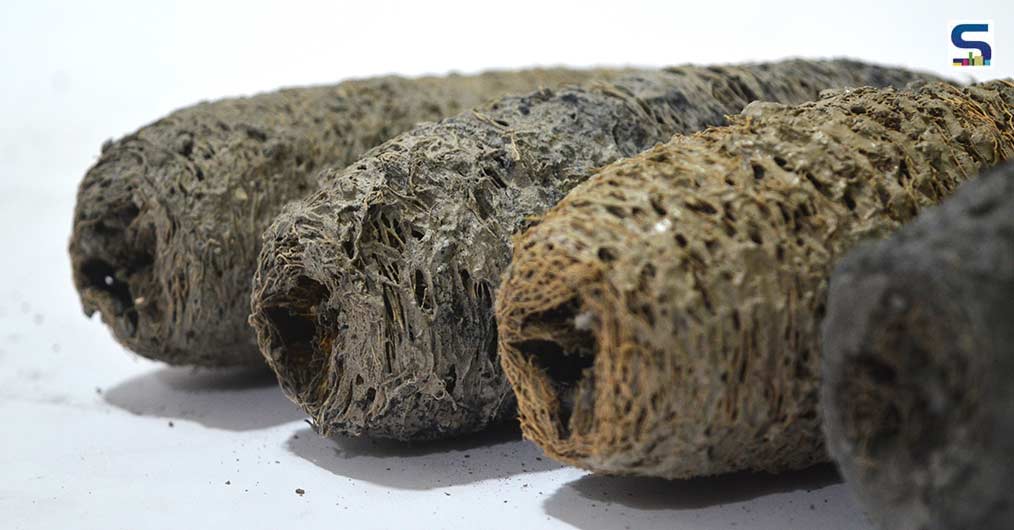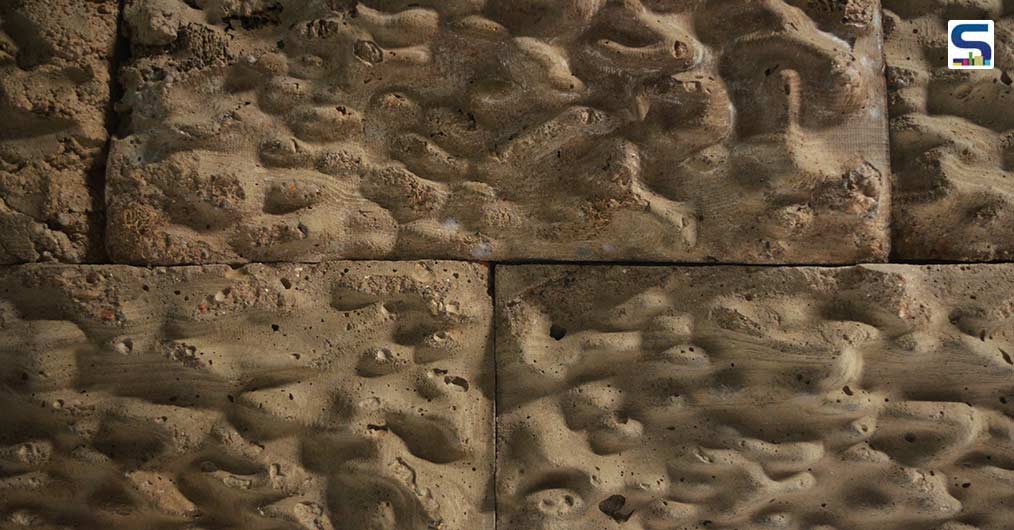
Construction activities including concrete are responsible for about 8 per cent to 15 per cent of the world’s carbon dioxide emissions. The building industry, hence, continues to be one of the largest contributors to global warming and climate change. In addition, concrete from demolished buildings, adds to the particulate pollution and is dumped into landfills as the industry lacks an efficient formal system of recycling, especially in India.
 Top: Plants taking roots and growing in the Green Charcol biodegradable brick; Above: Exploration of different percentage of charcoal and concrete to test adsorption, porosity and strength of the mix.
Top: Plants taking roots and growing in the Green Charcol biodegradable brick; Above: Exploration of different percentage of charcoal and concrete to test adsorption, porosity and strength of the mix.
What is Green Charcoal Brick?
Engineered as an alternative to concrete, the Green Charcoal Brick is an intersection of material innovation and technology that addresses the issue of rising pollution and temperature. Led by principal researcher Shreyas More, co-founder and co-director, New Materials Research Centre, and Adjunct Faculty-Interior Design, Indian School of Design and Innovation, the research is a development of cutting-edge materials for construction made from charcoal, organic luffa fibres, soil and air to create a biodegradable, lightweight built system that allows the growth of living ecosystems of plants and insects on its surface.
 Process prototype.
Process prototype.
How does it work?
Its luffa’s fibrous network not only provides strength, flexibility and porosity but also delivers anchorage for plants and acts as thousands of tiny water tanks, thereby cooling the interior environment. With an aim to create more sustainable building materials for the construction industry, the research team is further exploring different treatments to create a variety of bricks. Charcoal, being one of the components of the biodegradable brick mixture which is an adsorbent of nitrates, is used in small portions on the surface. This creates a codependent system where the charcoal adsorbs impurities from the air that serves as nutrition for the plants to feed on.
 The Green Charcoal biodegradabe brick with luffa reinforcements (L) and without luffa reinforcements (R).
The Green Charcoal biodegradabe brick with luffa reinforcements (L) and without luffa reinforcements (R).
Future of architecture
The Green Charcoal Brick allows biodiversity of plant and insect species. It offers passive cooling of the interior environment and purifies the air. The green charcoal material composite has a 90 per cent reduction in the use of coarse aggregate, 4 per cent reduction in cement, 4 per cent reduction in fine aggregate and 21 per cent increase in air pockets. Effectively, it has a 54 per cent increase in organic matter as compared to a standard concrete block.
 Testing surface undulations on the bricks to provide micro light-shadow conditions for small plants and better anchorage for the root.
Testing surface undulations on the bricks to provide micro light-shadow conditions for small plants and better anchorage for the root.
Additionally, the Green Charcoal Brick replaces metal reinforcements found in standard RCC. Different surface treatments have been explored with the design of bricks using the bio-mixture. Its organic undulating surfaces are aimed to facilitate better anchorage for plant roots and also to guide them to grow in a certain fashion. The Green Charcoal Brick gives people a sense of material connection with nature which is comforting and a visual connection with natural patterns which are stimulating. By changing the variables and ratios of the material composition, the green charcoal mixture has the potential of opening up diverse applications in built environments. This material could be developed for road curbs and divider, plastering and cladding materials or could be realised into construction bricks for low structural strength like compound walls and moderate strength filler walls.
 Modular self-shading soilcrete brick made using the Green Charcoal mix.
Modular self-shading soilcrete brick made using the Green Charcoal mix.
The team is contining its research on explore biophilic material compositions, climatic performance, natural colour palettes and patterns to make the future cities a healthier place to live in.
 Seeds germinating into seedlings in the Green Charcoal mix representing cycle of rebirth.
Seeds germinating into seedlings in the Green Charcoal mix representing cycle of rebirth.
Image credits: The designer